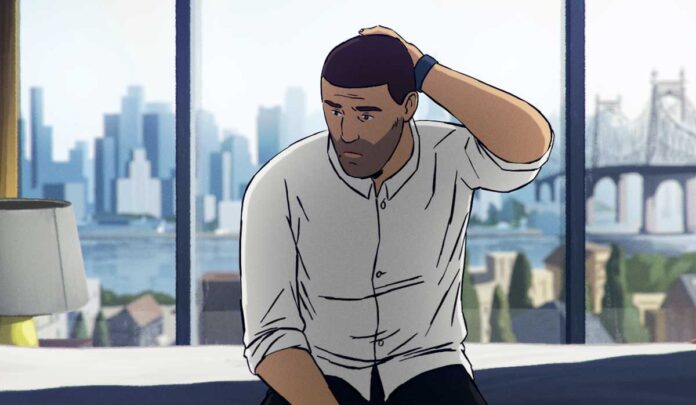Director Jonas Poher Rasmussen’s remarkable documentary, “Flee,” which is now available on Hulu and on DVD, has been nominated for three Oscars — Best International Film, Best Animated Film, and Best Documentary. (Its strongest chance is in the highly competitive documentary feature category, and here’s hoping it will squeak out a win.)
The film tells the true story of the director’s friend Amin, whom he first met as a teenager in Denmark. Amin, who is gay and Afghan, has never told his life story — until now. And the film artfully dissolves into a flashback/memory of Amin as a child in 1984 Kabul, running through the streets in his sister’s nightgown. The playful image shows his youthful exuberance and his “tendency to be a little different.” But his happiness is short-lived.
As his story unfolds, Amin recounts his father being jailed and disappeared for being a suspected threat to the government. His brother tries to avoid military service in one sequence because going into the army is almost certain death. Rasmussen films the authority figures throughout the film in black and white and as faceless characters to effectively convey the horrors of enforced power.
“Flee” toggles back and forth in time as Rasmussen interviews Amin about his life, and the approach comes off as a kind of intimate, extended therapy session. The film shows Amin’s adult life in Denmark where he lives with his boyfriend, Kasper. The couple, who are unmarried, are looking for a house, but Amin is also planning to go to Princeton for a post-doc opportunity — he emphasizes the importance of his education — which puts a strain on their relationship
Home is an even more important concept for Amin. The film opens with him talking about what home means for him in a poignant voiceover. He wants something that is not temporary, a safe space where he can be himself — a gay Afghan refugee — and feel a sense of stability. Much of his life has involved uncertainty, and Amin’s fears about being caught are palpable. One anecdote has Amin worrying that an ex-boyfriend will rat him out for a lie that he told to get asylum. (Amin’s “story” is that his family is dead — but that is untrue; his siblings and mother are still very much alive.)
“Flee” is affecting and impactful because Rasmussen allows Amin to process his thoughts about home, identity, and sexuality over the course of the film. He acknowledges his attraction to men began when he was 5 or 6 and his boyhood crush on Jean-Claude Van Damme. But he fears coming out will bring shame on his family, given that homosexuality is not discussed in Afghan culture. A scene late in the film when he does tell his siblings that he is gay is touching. Moreover, it includes a gesture by his brother that is likely to induce happy tears.
One of the many strengths of Rasmussen’s film is how it shows the ripple effect of Amin’s story on his other family members. The struggles he and his family face leaving the dangers of Afghanistan behind in 1989 and trying to find safety elsewhere are fraught with anxiety. Living with expired documents in Moscow — a post-Glasnost Russia is the only country that would let the family in — Amin, his siblings, and their mother encounter a series of hardships and setbacks. They are also constantly evading authorities. One encounter Amir and his brother have when they are in the back of a police van is particularly haunting.
“Flee” is often moving as Amin talks about the sacrifices he and his family made and the burden of responsibility he feels. And scenes that illustrate this are among the most striking. There are several harrowing sequences in which family members are smuggled across borders in inhumane conditions. Rasmussen occasionally shows real footage of events, which are vivid, but the animated sequences are powerful enough. (Most, but not all, of the cutaways to news clips report on the situation in Kabul and the Soviet withdrawal that prompted Amin and his family’s exodus).
Rasmussen deftly uses the animation to illustrate passages of time, the difficulties experienced by refugees and in human trafficking, as well as cues of queerness (like a wink from Van Damme). The animation often employs light and shadow and color for emotion or memory and the stylized film never feels gimmicky.
Amin wisely entrusted Rasmussen to tell his story, which is personal and political, and undeniably heartfelt. An opening credit indicates that the names and locations have been altered to protect individuals. This may be why there are some gaps in the story — how Rasmussen and Amin meet is included, but how Amin and Kasper met is not; and Amin’s studies at Princeton are left vague. Then there is a beautiful exchange Amin has with a young man who is being smuggled out of Russia with him. Amin cannot remember the young man’s name despite their brief but meaningful encounter. But memory is like that, especially when processing trauma.
“Flee” is an outstanding film about a gay refugee’s emotion-filled experiences.

